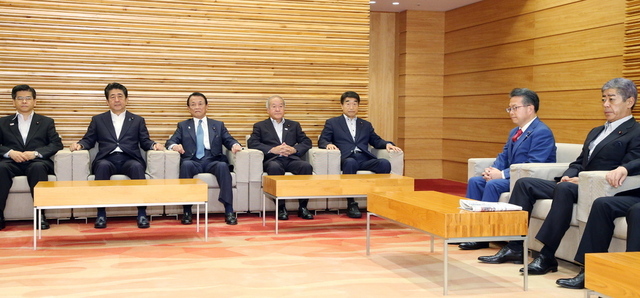Posted on : Aug.9,2019 17:26 KST
Modified on : Aug.9,2019 17:51 KST
 |
|
Japanese Prime Minister Shinzo Abe (second from left) and Trade Minister Seko Hiroshige (second from right) attend a Cabinet meeting in Tokyo on Aug. 2 regarding the removal of South Korea from Japan’s white list of countries receiving preferential treatment in exports. (EPA/Yonhap News)
|
On Aug. 8, the Japanese government announced that it had approved the export of extreme ultraviolet (EUV) photoresist, which is one of the first semiconductor materials Japan implemented export restrictions on. This is the first time in around a month Japan has allowed exports since restricting exports to South Korea of three semiconductor materials, including hydrogen fluoride (also known as etching gas).
Japan has thus far avoided expanding the “individual approval” of items it announced that would make it difficult for South Korea to seek approval for shipments. The Japanese government now appears to be avoiding escalating the conflict over exports to South Korea. However, it is highly likely that Japan’s latest move is just a temporary gesture to strengthen its justification for implementing export controls in the first place. If the Shinzo Abe administration has any intention of ensuring the current situation does not damage the economy of either country, it should immediately move to engage in dialogue and negotiations through diplomatic and trade channels with South Korea.
In response to Japan’s approval of the exports, the South Korean government also discussed removing Japan from its “white list” on Aug. 8. However, government ministers and other senior officials decided to delay this action during a meeting presided over by Prime Minister Lee Nak-yeon, calling for Japan to find a diplomatic solution to the problem. South Korean President Moon Jae-in pointed out that the measures Japan had implemented up until this point have not been beneficial to the economies or people of both countries. That is accurate. While South Korea’s economy is now faced with greater uncertainty due to Japan’s economic measures, Japan has also seen damage to its tourist and materials export industries.
Japan’s apparent hesitation to expand the conflict does not necessarily indicate that it is ready to find a fundamental resolution with South Korea. Rather, after its initiation of the conflict, Japan is now “taking a rest” as it tries to persuade the international community its export controls are justified. This is proven by Trade Minister Seko Hiroshige stating recently that “I hope South Korea understands that this is not an export ban” and that Japan would take additional measures if violations are discovered. In short, Japan has threatened to use export controls whenever it feels they are needed. If the export controls are indeed not aimed at “taking revenge” against South Korea then Japan should respond positively to the South Korean government’s efforts to find a diplomatic resolution.
The South Korean government, for its part, should avoid overestimating the significance of Japan’s succession of “yielding moves” and respond to them both rationally and prudently. While it may seem that Japan is taking a step back from the brink, in reality the Japanese government is doing nothing more than taking a break after perpetrating its “economic provocation” of implementing export controls and removing South Korea from its white list. The effective responses to Japan’s actions by the South Korean government and its people have likely contributed to Japan’s hesitation. South Korea must continue to show a firm stance until Japan removes all of the export restrictions in place.
Please direct comments or questions to [english@hani.co.kr]









